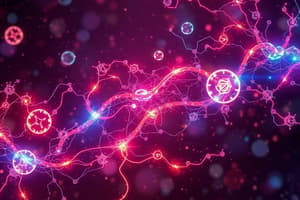Podcast
Questions and Answers
What is the main rationale for hematopoietic cell transplantation (HCT) in IEMs?
What is the main rationale for hematopoietic cell transplantation (HCT) in IEMs?
- To stimulate the production of enzymes
- To provide correcting enzymes by donor cells within and outside the blood compartment (correct)
- To remove defective genes
- To replace damaged cells with healthy ones
What is the recommended dosage of raw cornstarch for preventing hypoglycaemia in older children with glycogen storage disease type I?
What is the recommended dosage of raw cornstarch for preventing hypoglycaemia in older children with glycogen storage disease type I?
- 3 g/kg every six hours
- 4 g/kg every six hours
- 1 g/kg every six hours
- 2 g/kg every six hours (correct)
What type of tissue or fluid is required for prenatal diagnosis of IEMs?
What type of tissue or fluid is required for prenatal diagnosis of IEMs?
- Skin cells
- Blood samples
- Chorionic Villous tissue or Amniotic fluid (correct)
- Urine samples
What is the purpose of enzyme replacement therapy (ERT)?
What is the purpose of enzyme replacement therapy (ERT)?
What is the recurrence risk of IEMs if the diagnosis is known and confirmed in the index case?
What is the recurrence risk of IEMs if the diagnosis is known and confirmed in the index case?
What is the name of the technique used in some countries for neonatal screening of IEMs?
What is the name of the technique used in some countries for neonatal screening of IEMs?
What type of disorders can be detected by tandem mass spectrometry?
What type of disorders can be detected by tandem mass spectrometry?
What is one of the limitations of using tandem mass spectrometry for neonatal screening?
What is one of the limitations of using tandem mass spectrometry for neonatal screening?
What is the mode of inheritance of most IEMs?
What is the mode of inheritance of most IEMs?
What is the goal of genetic counselling in IEMs?
What is the goal of genetic counselling in IEMs?
Flashcards are hidden until you start studying
Study Notes
Anabolism
- Anabolism is the set of metabolic pathways that construct molecules from smaller units, requiring energy.
Inborn Errors of Metabolism (IEM)
- IEMs occur due to mutations in DNA, affecting specific proteins such as enzymes, receptors, transport vehicles, or membrane pumps.
- Examples of mechanisms in IEM:
- Precursor → Enzyme AB → A → Enzyme BC → B → End Product C
- Abnormal metabolic pathway → Toxic Metabolite D
- Inborn errors of metabolism can be divided into three pathophysiological diagnostic groups:
- Group 1: Anabolism/Catabolism
- Group 2: Intermediary Metabolism (Urea cycle disorders, some lysosomal disorders)
- Group 3: Energy Production/Utilization (Mitochondrial defects, respiratory chain disorders, Krebs cycle and pyruvate oxidation defects)
Classification of IEM
-
- Carbohydrate metabolism
-
- Organic acid metabolism
-
- Lipid metabolism
-
- Protein metabolism
-
- Amino acid metabolism
-
- Mitochondrial fatty acid oxidation
Approach to IEM
- Suspecting inborn errors:
- Symptoms accompanying diet changes
- Seizures
- Developmental delay
- Recurrent vomiting
- Unusual urine odor
- Parental consanguinity
- Family history of inborn errors
- Investigations:
- First-line tests
- Second-line tests (ancillary and confirmatory tests): - Gas chromatography mass spectrometry (GCMS) - Plasma amino acids and acyl carnitine profile by Tandem mass spectrometry (TMS) - High-performance liquid chromatography (HPLC) - Lactate/pyruvate ratio - Urinary orotic acid test - Enzyme assay - Neuroimaging (MRI) - Magnetic resonance spectroscopy (MRS) - Electroencephalography (EEG) - Plasma very long chain fatty acid (VLCFA) levels - Mutation analysis - CSF amino acid analysis
Treatment of IEM
- Aims of treatment:
- Reduce toxic metabolite formation
- Provide adequate calories
- Enhance toxic metabolite excretion
- Supportive care
- Long-term treatment:
- Dietary treatment (protein restriction)
- Replacement of end products
- Enzyme replacement therapy (ERT)
- Transplantation and Gene Therapy
- Hematopoietic cell transplantation (HCT)
Prevention
- Genetic counselling and prenatal diagnosis:
- Autosomal recessive inheritance
- 25% recurrence risk
- Prenatal diagnosis available for subsequent pregnancies
- Neonatal screening:
- Tandem mass spectrometry (TMS)
- Detects amino acidopathies, fatty acid oxidation defects, and organic acidemias
- High sensitivity but low specificity
Studying That Suits You
Use AI to generate personalized quizzes and flashcards to suit your learning preferences.



